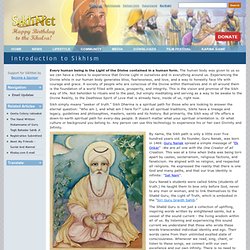

Encyclopedia.com articles about Sikhism. Introduction to Sikhism. Every human being is the Light of the Divine contained in a human form.

The human body was given to us so we can have a chance to experience that Divine Light in ourselves and in everything around us. Experiencing the Divine while in our human body generates bliss, fearlessness, and love, and a way to honestly face life with courage and grace. A society of people who are conscious of the Divine within themselves and in all around them is the foundation of a world filled with peace, prosperity, and integrity. This is the vision and promise of the Sikh way of life. Not beholden to rituals and to the past, but simply meditating and serving as a way to be awake to the Divine Reality, to the Deathless Spirit of Love that is already here, inside of us, right now.
Sikh simply means "seeker of truth. " By name, the Sikh path is only a little over five hundred years old. Guru Nanak's students were called Sikhs (students of truth.) Fast Facts on Sikhism. 43.7KGoogle + Overview of Sikhism The word "Sikhism" derives from "Sikh," which means a strong and able disciple.

There are about 23 million Sikhs worldwide, making Sikhism the 5th largest religion in the world. Approximately 19 million Sikhs live in India, primarily in the state of Punjab. Large populations of Sikhs can also be found in the United Kingdom, Canada, and the United States. Sikhism emerged in 16th-century India in an environment heavily permeated with conflicts between the Hindu and Muslim religions. Sikhism was founded by Guru Nanak Dev, who was born in 1469 to a Hindu family. Retaining the Hindu doctrine of the transmigration of souls, together with its corollary, the law of karma, Guru Nanak advised his followers to end the cycle of reincarnation by living a disciplined life – that is, by moderating egoism and sensuous delights, to live in a balanced worldly manner, and by accepting ultimate reality. Facts and Stats on Sikhism name founded c. 1500 in India founder adherents. Sikhism Religion of the Sikh People. SIKHISM: Beliefs, paractices, symbol, names.
Sponsored link.

Sikh Beliefs: Sikh Practices: The Khanda -- the Sikh symbol The Khanda is the main Sikh symbol. It is seen at the top of this essay, used by permission of www.hatisoft.com 4 It is composed of four items, all traditional Sikh weapons: The Khanda has been interpreted symbolically in many ways. one is: "The Sikh emblem, Khanda, contains a ring of steel representing the Unity of God, a two edged sword symbolizing God's concern for truth and justice, and two crossed swords curved around the outside to signify God's spiritual power. " 4 Sponsored link: Sikh names: One unusual feature of Sikhism is that all Sikh males share the name: "Singh" which means "lion.
" References used: The following information sources were used to prepare and update the above essay. "Message of Sikhism," All About Sikhs, at: Narinder A Singh, "Hindu Sikh Relations," at: is the Reht Maryada? " Copyright © 1996 to 2010 by Ontario Consultants on Religious Tolerance Latest update 2010-APR-04 Author: B.A. The Ten Gurus of Sikh History - A Timeline of the Ten Gurus and Guru Granth Sahib - The 10 Gurus of Sikhism. SIKHISM: origin, history, holy text. Sikhism does contain many unique postulates and principles that are quite different from both Hinduism and Islam.

Joseph D. Cunningham (1812-1851), the author of "A History of the Sikhs" (1848), observed: "It has been usual to regard the Sikhs as essentially Hindu... yet in religious faith and worldly aspiration, they are wholly different from other Indians, and they are bound together by an objective unknown elsewhere. " Sikh History: The founder of Sikhism was Shri Guru Nanak Dev Ji, (1469-1538) who was born in the Punjab area of what is now Pakistan. At Sultanpur, he received a vision to preach the way to enlightenment and God. A succession of nine Gurus (regarded as reincarnations of Guru Nanak) led the movement during the period from Guru Nanak's death until 1708.